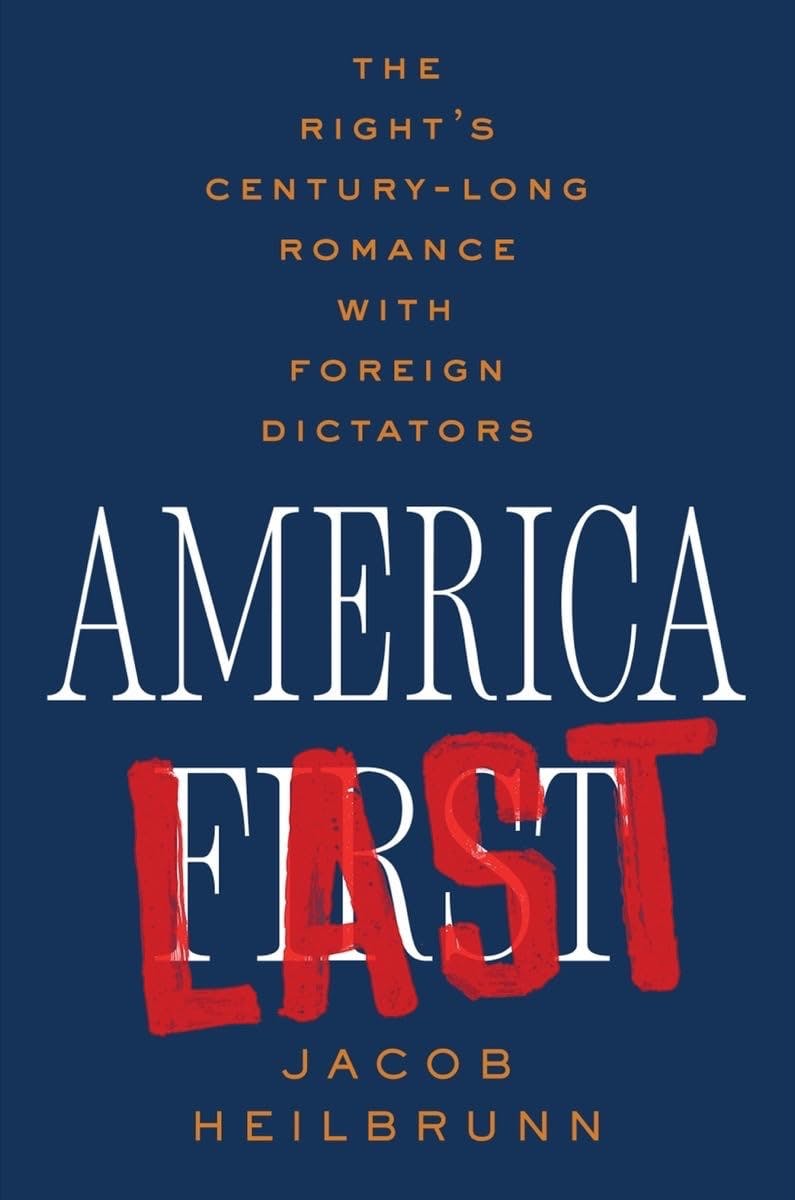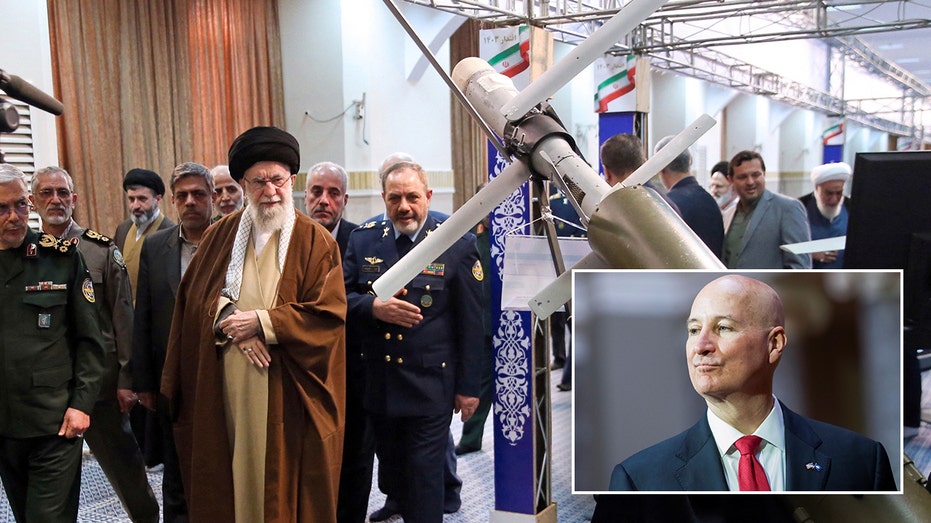The American Right’s Dictator Fan Club
To Americans whose formative political years ran across the Clinton and Obama presidencies, through the “end of history” and the arrival of free-market liberal democracy as the final form of government, Donald Trump’s rise to power in 2016 remains difficult to understand. Much ink has been devoted, in the eight years since, to placing the MAGA phenomenon in historical context. And “historical” has been the key word. Popular tomes from Rachel Maddow’s Prequel to more scholarly work like Bradley Hart’s Hitler’s American Friends or Kathryn Olmsted’s The Newspaper Axis: Six Press Barons Who Enabled Hitler have left no doubt as to the prevalence of pro-fascist sentiment in the United States in the interwar years.What has been absent is a road map to connect that era to the reemergence of openly illiberal politics in the present. Even a diligent reader could be forgiven for wondering what happened to all the American admirers of Hitler and Mussolini between 1941 and 2016. Jacob Heilbrunn’s new America Last: The Right’s Century-Long Romance With Foreign Dictators promises and delivers a systematic look at more than a century of open adulation of dictators and strongmen by prominent figures on the American right. The way the modern right fawns over Viktor Orbán or Vladimir Putin might be shocking in the context of Obama-era liberal assumptions about the political landscape. Yet it makes perfect sense in light of earlier paeans to Franco, Pinochet, and anyone else the American right could idealize as a real-world manifestation of desire for “throne and altar” conservatism, unfettered by poisonous liberal constructs like human rights or the rule of law. H.L. Mencken’s yearning for “the mailed fist and the prophet” of Kaiser Wilhelm, William F. Buckley Jr.’s slobbering over Franco as a modern-day Holy Roman Emperor, and Tucker Carlson’s soft spot for Putin are clearly enough threads from the same cloth.Heilbrunn’s rogues’ gallery of dictator fans, up until the waning years of the twentieth century, begins with the cult of Kaiser Wilhelm leading up to, during, and after World War I. H.L. Mencken is representative of the kind of aristocratic, Ivy League figures who openly pined for their imagined version of Germanic “strength” and “order” in contrast to the decadent, mob-ruled, and immigrant-weakened United States. Mussolini and Hitler were the next beneficiaries during the Roaring Twenties and early years of the Depression. Reactionary organizations like the American Legion openly admired what Mussolini’s brownshirts were able to do in Italy, noting how much they yearned to imitate the example (“If ever needed, the American Legion stands ready to protect our country’s institutions and ideals as the Fascisti dealt with the destructionists who menaced Italy,” Legion National Commander Alvin Owsley boasted in 1923). Elsewhere on the right, prominent intellectual Irving Babbitt declared in his still-influential Democracy and Leadership (1924) that “circumstances may arrive when we may esteem ourselves fortunate if we get the American equivalent of a Mussolini.”Admiration of that lamentable pair led many on the far right, in the early years of the Cold War, to a revisionist history of World War II that positioned Nazi Germany as the hapless victim of American scheming. (Sound familiar?) Over the following decades countless right-wing strongmen—Pinochet, Franco, António de Oliveira Salazar of Portugal’s fascist Estado Novo regime, Jonas Savimbi (portrayed with straight faces as the Angolan George Washington), and anyone else who could demonstrate anti-Communist bona fides, however atrocious their crimes—found a robust fan base somewhere in the ecosystem of American conservatism. In some cases the fans were intellectuals or writers. Buckley excitedly led the charge to defend Francoist Spain and apartheid South Africa (his 1957 pro-Franco missive, “Letter From Spain,” remains nauseating reading 75 years on). In other cases, the dictators’ cheerleaders were people in positions of real power. Reagan-era fixture Jeane Kirkpatrick worked behind the scenes right in the halls of power to push the agendas of dictators. Even America’s long, close alliance with the United Kingdom was not enough to prevent her from vociferously defending Argentine strongman Leopoldo Galtieri during the Falklands War. With the collapse of the Cold War and its assumptions, there was a brief lull in dictator fandom—after all, liberal democracy had just achieved its long-sought “victory”—but revanchist figures like Pat Buchanan kept the fires burning from outside mainstream conservatism. Buchanan’s antipathy for (mostly Jewish) neoconservatives was flagged as thinly veiled antisemitism even by other illiberal conservatives like Buckley, a charge not easily refuted given Buchanan’s habit of lauding Hitler in print (he was “an individual of great courage, a soldier’s soldier in the Great War, a leader steeped in the history of Europe, who possessed oratorical

To Americans whose formative political years ran across the Clinton and Obama presidencies, through the “end of history” and the arrival of free-market liberal democracy as the final form of government, Donald Trump’s rise to power in 2016 remains difficult to understand. Much ink has been devoted, in the eight years since, to placing the MAGA phenomenon in historical context. And “historical” has been the key word. Popular tomes from Rachel Maddow’s Prequel to more scholarly work like Bradley Hart’s Hitler’s American Friends or Kathryn Olmsted’s The Newspaper Axis: Six Press Barons Who Enabled Hitler have left no doubt as to the prevalence of pro-fascist sentiment in the United States in the interwar years.
What has been absent is a road map to connect that era to the reemergence of openly illiberal politics in the present. Even a diligent reader could be forgiven for wondering what happened to all the American admirers of Hitler and Mussolini between 1941 and 2016. Jacob Heilbrunn’s new America Last: The Right’s Century-Long Romance With Foreign Dictators promises and delivers a systematic look at more than a century of open adulation of dictators and strongmen by prominent figures on the American right.
The way the modern right fawns over Viktor Orbán or Vladimir Putin might be shocking in the context of Obama-era liberal assumptions about the political landscape. Yet it makes perfect sense in light of earlier paeans to Franco, Pinochet, and anyone else the American right could idealize as a real-world manifestation of desire for “throne and altar” conservatism, unfettered by poisonous liberal constructs like human rights or the rule of law. H.L. Mencken’s yearning for “the mailed fist and the prophet” of Kaiser Wilhelm, William F. Buckley Jr.’s slobbering over Franco as a modern-day Holy Roman Emperor, and Tucker Carlson’s soft spot for Putin are clearly enough threads from the same cloth.

Heilbrunn’s rogues’ gallery of dictator fans, up until the waning years of the twentieth century, begins with the cult of Kaiser Wilhelm leading up to, during, and after World War I. H.L. Mencken is representative of the kind of aristocratic, Ivy League figures who openly pined for their imagined version of Germanic “strength” and “order” in contrast to the decadent, mob-ruled, and immigrant-weakened United States. Mussolini and Hitler were the next beneficiaries during the Roaring Twenties and early years of the Depression. Reactionary organizations like the American Legion openly admired what Mussolini’s brownshirts were able to do in Italy, noting how much they yearned to imitate the example (“If ever needed, the American Legion stands ready to protect our country’s institutions and ideals as the Fascisti dealt with the destructionists who menaced Italy,” Legion National Commander Alvin Owsley boasted in 1923). Elsewhere on the right, prominent intellectual Irving Babbitt declared in his still-influential Democracy and Leadership (1924) that “circumstances may arrive when we may esteem ourselves fortunate if we get the American equivalent of a Mussolini.”
Admiration of that lamentable pair led many on the far right, in the early years of the Cold War, to a revisionist history of World War II that positioned Nazi Germany as the hapless victim of American scheming. (Sound familiar?) Over the following decades countless right-wing strongmen—Pinochet, Franco, António de Oliveira Salazar of Portugal’s fascist Estado Novo regime, Jonas Savimbi (portrayed with straight faces as the Angolan George Washington), and anyone else who could demonstrate anti-Communist bona fides, however atrocious their crimes—found a robust fan base somewhere in the ecosystem of American conservatism.
In some cases the fans were intellectuals or writers. Buckley excitedly led the charge to defend Francoist Spain and apartheid South Africa (his 1957 pro-Franco missive, “Letter From Spain,” remains nauseating reading 75 years on). In other cases, the dictators’ cheerleaders were people in positions of real power. Reagan-era fixture Jeane Kirkpatrick worked behind the scenes right in the halls of power to push the agendas of dictators. Even America’s long, close alliance with the United Kingdom was not enough to prevent her from vociferously defending Argentine strongman Leopoldo Galtieri during the Falklands War. With the collapse of the Cold War and its assumptions, there was a brief lull in dictator fandom—after all, liberal democracy had just achieved its long-sought “victory”—but revanchist figures like Pat Buchanan kept the fires burning from outside mainstream conservatism. Buchanan’s antipathy for (mostly Jewish) neoconservatives was flagged as thinly veiled antisemitism even by other illiberal conservatives like Buckley, a charge not easily refuted given Buchanan’s habit of lauding Hitler in print (he was “an individual of great courage, a soldier’s soldier in the Great War, a leader steeped in the history of Europe, who possessed oratorical powers that could awe even those who despised him”).
Finally, Heilbrunn explains, the failure of neoconservative foreign policy (the Iraq disaster) and the global financial crisis put paid to what we might recognize as “normal” conservative politics and left the door wide open for the forces of illiberalism to reassert themselves. George W. Bush’s adventurism in Iraq, none of which went according to the promises his administration made in advance of the invasion, gave powerful ammunition to isolationists of the “old right”; the Buchanan-founded magazine The American Conservative made anti-interventionism the centerpiece of its war on the neocons (in 2022, founding editor Scott McConnell noted that in 2002 ideas like bashing NATO and opposing free trade “seemed nuts,” but two decades on became bedrock Republican principles).
By opening and closing the book with the modern American right’s adulation of Orbán and Putin, Heilbrunn makes clear the stakes and relevance of the historical narrative. We know where a century of dictator-worship leads because the end point is our reality. There is a temptation, then, to drive home a very clear comparison: Mencken, George Sylvester, and Harry Elmer Barnes—interwar-era disdainers of democracy and admirers of what they saw as enlightened despots—map cleanly onto today’s “intellectual dark web” of media-savvy reactionaries. Americans who lauded Mussolini for being brave enough, Heilbrunn writes, to “(dispense) with democracy to defend traditional religion and family values” were using language we hear today in fawning pieces about Orbán or Putin. What is Sinclair Lewis’s character Adelaide Gimmitch in 1935’s It Can’t Happen Here but Moms for Liberty or “Libs of TikTok” for the Depression era?
What is striking throughout this history is the right’s foundational belief that other countries—other undemocratic countries—are simply better than the United States, in ways they tap-dance around but rarely quantify. Franco’s Spain had a “better work ethic.” Wilhelm’s Germany was more “manly” and “orderly.” Hitler and Mussolini brought their struggling nations a vague, gauzy “greatness.” Pinochet made Chile “strong.” The other country is always a role model, an example of what the U.S. could be if not for all the pesky liberal traps like elections, civil rights, diversity, or individual liberty.
What becomes clear is that, historically, the illiberal right viewed politics as a battle between elite and mob rule rather than as an ideological divide within an established liberal democratic order. But when that order was dominant in the post–World War II era, it was a continuous challenge for fans of dictators to cut their arguments to the fashions of the day. Thus was born decades of pointless hair-splitting and wish-casting (that right-wing dictatorships sometimes transition to democracy, but left-wing ones never do was a popular Nixon-Reagan-era article of faith) to justify why sometimes democracy was good and sometimes it wasn’t, why some authoritarian rule was bad and some was virtuous. None of it made sense, none of it was consistent enough to approach the status of principle, and with the slightest scrutiny it revealed itself to be opportunistic cheap talk.
The timeline proves that fondness for autocrats has always been a feature of American conservatism, but the logic behind it has proven malleable. What began as Ivy Leaguers pining for a hereditary aristocracy to tame the rabble transitioned into a pragmatic extension of Cold War ideology—anyone who served American interests was good, full stop, and any of a list of names of Cold War–era brutes serves to make the point. Many figures like Buckley even openly praised the great pariah of the late Cold War, apartheid South Africa, using arguments cut to the fashions of the time (anti-communism in public pronouncements, the language of white supremacy in private). Today, shorn of both the context of the Cold War and the fashionable elitism of Mencken’s era, we see dictator fandom most clearly for what it really is: disdain for the very concept of democracy whenever it fails to produce outcomes acceptable to the far right.
Where this book shines is in making a methodical “nothing new under the sun” argument; it demonstrates ample precedent for our current reality, in which illiberal politics are gaining strength worldwide. Where it leaves the reader wanting is in drawing out the subtle, qualitative differences in the way the modern right admires its favorite foreign despots. Many of the examples from the past—Mencken’s adulation of Imperial Germany, interwar yearnings for the iron fist of a Mussolini or Hitler, Buckley Jr.’s Franco and Pinochet worship—speak to a kind of paleoconservatism or “old right” that glorified the rule of church and state, of capital-letters Culture and Order. People who considered themselves intellectuals accordingly couched their praise in an intellectualized framework.
Today, though, what Heilbrunn calls the conservative search “for a paradise abroad that can serve as a model at home” manages only the most half-assed attempts at high-minded oratory. A few bought-off scholarly types and pundits, on frequent junkets to Hungary on the dime of Orbán’s Fidesz party and the global network of foundations on the antidemocratic right, appear periodically in the big magazines to try to bathe the movement in five-dollar words from half-remembered college classroom snippets—a Locke quote here, a breezy musing on popular sovereignty there.
But what dominates the current discourse is anything but this kind of undergraduate rhapsodizing. The current right barely disguises what boils down to an open lust for power. They don’t admire Pinochet because—as Cold War–era right-wing minds might have framed it—he brought “order” to Argentine society or supercharged its economy with the magic of free markets. They admire him because he had his opponents and enemies rounded up and shot. That’s it.
If that distinction seems academic or pedantic, it is in fact crucial. Much of this book’s narrative covers the Cold War era, when the American right could always frame its worship of strongmen abroad in the larger American mission to “save the free world from communism.” The Galtieris, the Pinochets, the Savimbis, and countless other reactionary despots around the world served a purpose—in the right’s view. Supporting these people advanced American interests in some tangible (if dubious) way. Now that pretense has been abandoned, and all that remains is violent revenge fantasies. More than at any point described in Heilbrunn’s extensive history, today’s right lusts after nothing more sophisticated than its idealized version of strength. These are less a bunch of aristocrats yearning for rule by hereditary elites and more a rabble that worships power for no motive more complex than anger, resentment, and a desire to punish.
That is an important quality that this book comes tantalizingly close to exploring but ultimately leaves for the reader only as a kind of narrative breadcrumb trail. It is hardly a fatal flaw, and the book offers much of value to readers interested in overlooked links between the past and present. The discussion of neoconservatism’s rise to dominance and then collapse into discredit on the right during the George W. Bush and Obama years is a particular standout (Heilbrunn’s previous book They Knew They Were Right was a history of the neocons). But like any book that attempts to tell a century-plus of history in 200 pages, there is a flattening; the need to emphasize the common thread obliterates some useful distinctions among the connected points. That what we see today is nothing new does not mean that nothing about it is novel.
With all evidence pointing toward the right continuing down this path for the foreseeable future, there will be a lamentably large number of opportunities for future books to explore that question.



